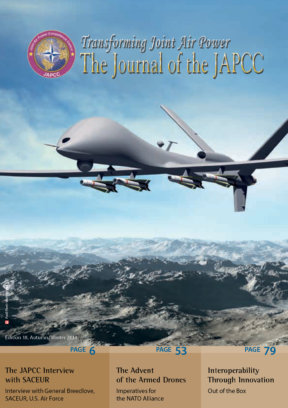Introduction
“A number of significant technology-related trends – including the development of laser weapons, electronic warfare and technologies that impede access to space – appear poised to have major global effects that will impact on NATO military planning and operations.”
NATO Strategic Concept 2010
Since its inception over one hundred years ago, aviation has always been at the leading edge of technology. For a long time, technological solutions and developments derived from the field of aviation have been used by industries. Aviation has been considered a real originator of research and development for a great number of technological advances. But this situation seems to have changed somewhat. Today, new technological developments from other branches of research and development are just as likely to be applied to the field of aviation. For this reason, it is important for air power theorists to be aware of current and future innovations expected to come from industry. This will help to improve the capabilities of existing weapon systems, and thus determine the best way to face both traditional and new threats. New trends in technologies such as nanotechnology, aero-elasticity, laser applications in communications or new synthetic fuels are going to be a familiar part of our lives in the near future. The aim of this article is to highlight the technological advances in the emerging field of nanotechnology and forecast how it could improve the future potential of air power capabilities by leveraging the new capabilities this technological advance may provide.
Nanotechnology
“Nanotechnology is an area which has highly promising prospects for turning fundamental research into successful innovations. Not only to boost the competitiveness of our industry but also to create new products that will make positive changes in the lives of our citizens, be it in medicine, environment, electronics or any other field.”
European Commissioner for Science & Research, Janez Potočnik
Nanotechnology is a branch of engineering concerned with manipulating materials on an atomic or molecular scale. The Institute of Nanotechnology in the U.K. defines it as “science and technology where dimensions and tolerances in the range of 0.1 nanometer (nm) to 100 nm play a critical role”. The first and most important advantage of manipulating material at the atomic / molecular level is the ability to obtain new physical features and behaviours of common materials with the possibility of obtaining new micro-machines based on those new features and behaviours. The possibilities for this burgeoning area of science are infinite and some theorists call this area of study “the industrial revolution of the 21st Century”.
Graphene
One of the most important examples of this phenomenon is Graphene1. It is a hexagonal honeycomb made entirely of a regular carbon structure material, one atom thick. The features of this new material are extraordinary. It is much stronger than steel but also much lighter. It is more electrically and thermally conductive than other conductive metals like copper. It is very flexible and almost transparent. It could be said that it is a film of diamond. A new wide horizon of possibilities and applications has opened, some of these include slim screens2, solar cells, batteries3, bulletproof vests, graphene muscles and electronic transistors that are much more efficient than current silicon transistors4. There are numerous possibilities that can be applied to the aeronautical field. The weight of aircraft components could be reduced as stronger, ultra-light fuselage components made of graphene are used as the foundation of a new generation of aircraft. Also, due to graphene’s optoelectronic properties, the entire fuselage could work like a full multisensory antenna5. The use of graphene is also being considered as a fuel additive as it could yield more efficiency, reduce environmental pollution and greenhouse gas emissions, while improving the aircraft endurance and payloads6.
Nanotubes
A nanotube is a tube with a nanometer scale structure, made mainly of rolled graphene7. In this form, the graphene acquires new features and improves existing ones. Nanotubes have extraordinary optical, thermal, chemical, mechanical and electrical properties8 and are currently being used to advance several scientific fields such as medicine, biology, chemistry, and technology. The key properties of carbon nanotubes are the ability to behave as a metal or a semiconductor9, and be modified by a nearby magnetic field. They also have unique optoelectronic10 and field emission properties11. Carbon nanotubes are stable at high temperatures and have very high thermo-conductivity in one axis, but acts as a thermal insulator in the other axis. This property, along with its strength, flexibility and lightness, makes nanotubes a good shield or armour against kinetic threats (body armour, light-weight armour for vulnerable aircraft structures, etc.), and electromagnetic and acoustic12 threats. Carbon nanotubes’ absorption capability makes them highly valuable as a Radar Absorbing Material (RAM) improving the ‘stealth’ capability of combat aircraft13. Aircraft wiring as it currently exists is close to its structural limitations. Construction of carbon nanotubes cables could result in more efficient and conductive wires than copper with better current density14 and corrosion resistance. They are much lighter and work in a wider range of temperatures with less cooling requirements. This could be a very important step forward in all technological fields but especially in the field of aeronautics15.
By using concentric multiwall nanotubes, it is possible to craft rotational nano-bearings with extremely low friction between telescopic nanotubes. Working as an actuator, nanotubes could facilitate the production of nano-machines and nano-robots, and even normal-sized machines. This rotational molecular system could be considered the smallest engine ever made. Since there is almost no friction between different nanotube walls, lubricants are unnecessary and nano-machine components will not wear out. Additionally, if an internal nanotube, inside a multi-walled one, slides out of its normal position, it tends to return back to its original position, working like a natural permanent telescopic spring. These characteristics of carbon nanotubes make them useful in enhancing the lubrication in gasoline engines, reducing friction by up to 40 % and hence the wear of the components while improving efficiency and decreasing fuel consumption16. Because carbon nanotubes have better conductive properties than common materials, improvements in processing speed and memory capacity could facilitate further electronic miniaturisation than is currently possible with existing technology.
Limitations
Similar to other technological developments throughout history, nanotechnology could be a double edged sword. Unfortunately, there are many unsolved questions regarding the use of, and exposure to, nanotubes. What are the environmental or health negative effects? What will be the interaction between nanomaterial and the human body? And finally, who is going to regulate the use of it?
The European Commission presented ‘Nanosciences and Nanotechnologies: an action plan for Europe 2005–2009’17. Many ethical, legal and societal aspects of this issue are addressed in this document. The study emphasised that all developments and applications derived from nanotechnology must be closely monitored with the highest level of health protection. It also underscored the need to ensure that technological advances are supported by parallel investigations about possible related risks and hazards18.
Nanotechnology and Military Applications – Science Fiction?
Nanotechnology and its application to aviation can be placed into two main categories, improvement of aerodynamic performance and improvement of weapons and sensors capabilities. Reducing weight by using lighter materials in combination with more efficient fuels and engines is one way to improve aircraft payload while increasing endurance. Using new RAM materials, paints and designs will make aircraft more ‘stealthy’. Through the employment of nanotechnology, future aircraft could have the following features:
- New aircraft designs with certain ‘morph-able’ capacities in some portion of its wings or fuselage. These could replace flaps, slats or winglets, or could change the profile of the wings depending of the flight conditions.
- With the fuselage or wings made, covered or even painted with carbon nanotubes, it is possible to make the aircraft more ‘stealthy’ against radars and even invisible to electro-optical systems in low visibility conditions or night, thanks to the absorption capabilities or the lack of electromagnetic refraction and reflection of these materials.
- By using carbon nanotubes and graphene along the fuselage or wings, aircraft could become a continuous sensor or early warning system. The optoelectronic properties of nanotubes make them an excellent receiver of external signals, not only electronic ones but detecting gases coming from missiles, submarines, aircraft, etc., or even as a biological / chemical warning alert device.
- In weaponeering, sensors could be used as seekers in the guidance of missiles or precision bombs against electronic transmitter or exhaust gases.
- As internal sensors19, carbon nanotubes could be distributed along sensitive aircraft parts such as hot zones in the engines, turbines, afterburner, etc., or into areas of extreme force like landing gear or wings roots, measuring temperatures, pressure or strain.
- Due to their strength and flexibility, carbon nanotubes and graphene might be used as armour or shielding for vulnerable zones in the aircraft. Even the canopy could be made with this transparent material. Hydrophobic properties of graphene give windshield and canopies better performance in the rain, even without wipers.
- By applying nanotechnology in electronic components, it is possible to increase the processing speed and memory capacity of existing silicon transistors, reducing the size and weight of electronic components. This means more space available, more useable payload and faster processing capability for aircraft computer systems. There are companies developing very slim and flexible displays made of graphene, which facilitates the construction of electronic control panels in aircraft where electronic circuits, transistors and other elements are included all on the same panel.
- Because of graphene’s fireproof characteristics, certain sensitive parts of this hypothetical future aircraft will be protected against fire with carbon nanotube shields or it could be used as a fire extinguisher powder in the case of on-board fires.
- Future aircraft could employ new lighter batteries with greatly improved electrical storage capacity. Also, if hydrogen becomes a source of fuel, carbon nanotubes can provide good hydrogen storage capability, solving one of the most difficult challenges in the use of hydrogen as a fuel.
All of the applications mentioned above in the hypothetical design of a future aircraft that uses the capabilities of nanotechnology are equally valid for other areas with military interest such as medicine, passive defence, force protection, C2 systems, energy storage, production of drinking water or water decontamination in air bases or into first aid kits, etc. The advance of science and future progress in the development of nanotechnology holds the key to bringing us all closer to these enormous benefits.












